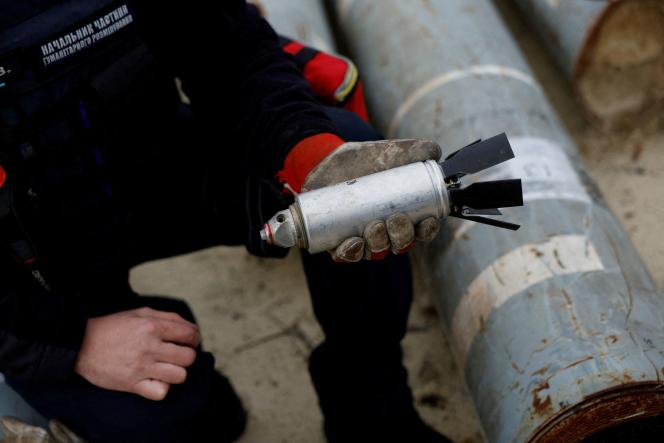Himars, combat tanks, long-range missiles and now, cluster munitions… The United States is preparing to supply Ukraine with these weapons banned by more than 100 countries because of their impact on populations civilians, the White House confirmed on Friday July 7, crossing an important threshold in the type of armaments offered to Kiev to defend itself against Russia.
“It’s a tough decision. We postponed it” some time, White House national security adviser Jake Sullivan told reporters, while adding that it was “the right thing to do” to help Ukraine in its counter-offensive against Russian forces.
Jake Sullivan claimed President Joe Biden made the decision in consultation with allies and after a “unanimous recommendation” of his administration. The official further assured that the Ukrainians had provided guarantees “in writing” on the use they would make of these weapons to minimize “the risks posed to civilians”.
This announcement comes as part of a new package of military aid to Ukraine amounting to $800 million and that brings total U.S. military aid since the war began in February 2022 to more than $41 billion. In addition to cluster munitions, the United States will provide armored vehicles, artillery munitions, anti-tank weapons and other equipment.
Explosive charges released in clusters
Cluster munitions contain multiple explosive charges released in clusters, unlike most missiles and bombs. Once the projectile has been fired, the ammunition container, which can be a rocket, a shell or even a missile, releases tens or even hundreds of explosives, the submunitions.
According to washington post, the United States will provide 155 mm artillery shells, the M864, in service since 1987. These shells carry dual-effect submunitions up to 29 kilometers: anti-personnel and anti-tank. The American daily reports that “In its last estimate made public, more than twenty years ago, the Pentagon claimed that this artillery shell had a 6% “misfire” rate, which means that at least four of the 72 submunitions transported by the shell would remain unexploded in an area of approximately 22,500 square meters”.
Thursday, during a briefing, the Pentagon spokesmanPat Ryder specified that the United States has several variants of DPICM shells (Dual-purpose improved conventional munition or “conventional enhanced dual purpose ammunition”). “The ones we plan to provide would not include older variants, which have a misfire rate of over 2.35%”he specified.
Closing the artillery gap against the Russians
Ukraine, for its part, asserts that the delivery of these weapons will enable it to make up at least in part for its deficit in terms of artillery vis-à-vis Russia. The United States also assures that Russia uses such weapons as part of its invasion of Ukraine launched in February 2022.
The World App
The Morning of the World
Every morning, find our selection of 20 articles not to be missed
Download the app
In 2006, a Senate information report explained that “the neutralization of armored targets seems to be one of the preferred applications of cluster munitions”, as was the case during the Cold War. According to this same report “submunitions can be designed for a specific effect (destruction of armor or airstrips, for example) or for combined effects (for example antipersonnel and antimateriel)”.
Convention on Cluster Munitions
But the use of these cluster munitions has sparked a wave of condemnations. Sending these weapons to Ukraine would be “escalatory, counter-productive and would only increase the danger for the civilian populations caught in the combat zones”denounced Daryl Kimball, director of the American organization Arms Control Association in a communicated. They “will not tell the difference between a Ukrainian soldier and a Russian soldier. The effectiveness of cluster bombs is vastly oversold and the impact on non-combatants is recognized but too often overlooked”he added.
The American decision “is a step backwards which undermines the considerable advances of the international community in its attempt to protect civilians from such dangers during and after armed conflicts”said for his part Amnesty Internationalasking Washington to reconsider its decision.
For its part, the NGO Human Rights Watch (HRW) recalls that cluster munitions are a violation of international humanitarian law. They do not make it possible to distinguish a civilian target from a military target and the NGO sends the Russians and the Ukrainiansaccusing them of using this ammunition against civilians: they act “like a landmine, posing a threat to civilians for years, if not decades”recalls HRW.
The Oslo Treaty was not signed by the belligerents
If Washington can assume to transfer these weapons to Ukraine, it is because neither the United States, nor Ukraine or Russia have signed the 2008 Oslo Treatywhich entered into force in 2010, and which prohibits the production, stockpiling, sale and use of cluster munitions.
The French Ministry of Foreign Affairs recalls, moreover, that the largest holders and producers of cluster munitions refuse to adhere to the convention. These include India, Israel, Pakistan, China or South Korea. Those countries “highlight the military necessity of these weapons”, is it explained.
